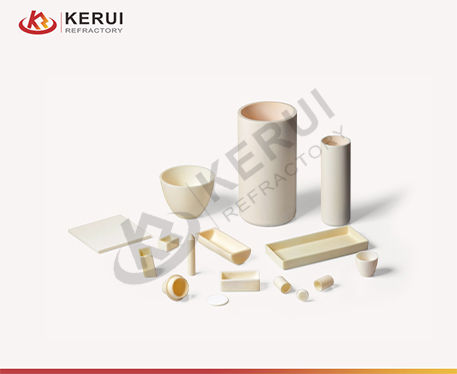24
0
0
Pottery Kiln Shelves for Ceramic Industry
Pottery kiln shelves are essential components in the ceramic industry, providing a stable and heat-resistant platform for firing ceramic wares. These shelves come in various sizes, shapes, and materials to accommodate different firing needs and ensure the proper firing of ceramic pieces.

Types of Pottery Kiln Shelves:
[ol]
Solid Shelves:
Solid shelves are the most common type of pottery kiln shelves, typically made from fireclay or high-alumina refractory materials. They offer a flat, stable surface for supporting a wide range of ceramic shapes and sizes.
Bat Wash Shelves:
Bat wash shelves are coated with a thin layer of bat wash, a mixture of clay and water, that creates a smooth, non-stick surface. This prevents ceramic pieces from sticking to the shelf, reducing the risk of damage during firing.
Perforated Shelves:
Perforated shelves feature holes or slits throughout their surface, allowing for better airflow and heat distribution within the kiln. This is particularly beneficial for firing delicate pieces or those that require even heating.
Kiln Posts:
Kiln posts are used to create a multi-level shelving system within the kiln. They are typically made from metal or refractory materials and can be adjusted to accommodate different shelf heights.
[/ol]
Materials for Pottery Kiln Shelves:
[ol]
Fireclay:
Fireclay is a common material for pottery kiln shelves due to its high refractoriness, meaning it can withstand high temperatures without melting or deforming. It is also relatively inexpensive and readily available.
High-Alumina Refractory:
High-alumina refractory shelves offer superior refractoriness and resistance to thermal shock, making them suitable for high-temperature firing and demanding applications.
Silicon Carbide:
Silicon carbide shelves are known for their exceptional heat conductivity, durability, and resistance to glaze adherence. They are often used in high-production environments or for firing delicate pieces.
[/ol]
Choosing the Right Pottery Kiln Shelf:
The selection of the appropriate pottery kiln shelf depends on several factors, including:
[ol]
Kiln Size and Capacity: Consider the size of your kiln and the number of pieces you typically fire to determine the shelf dimensions and quantity required.
Firing Temperature: Choose a shelf material that can withstand the maximum firing temperature you plan to use.
Type of Ceramic Pieces: Select a shelf type that is suitable for the specific ceramic pieces you will be firing, considering factors like shape, size, and glaze sensitivity.
Airflow Requirements: If even heat distribution and airflow are crucial, consider perforated shelves or a multi-level shelving system.
Budget: Evaluate the cost of different shelf materials and consider the long-term investment based on durability and performance.
[/ol]

Maintenance and Care of Pottery Kiln Shelves:
Proper maintenance and care of pottery kiln shelves can extend their lifespan and ensure optimal firing results:
[ol]
Cleaning: Clean shelves after each firing to remove any glaze residue or debris. Use a soft brush or damp cloth to avoid scratching the shelf surface.
Inspection: Regularly inspect shelves for cracks, chips, or other damage. Replace damaged shelves promptly to prevent safety hazards and ensure even firing.
Proper Loading: Avoid overloading shelves and ensure ceramic pieces are evenly spaced to allow for proper airflow and heat distribution.
Shelf Liners: Consider using shelf liners, such as kiln wash or kiln paper, to protect shelves from glaze adherence and make cleanup easier.
Storage: Store shelves in a dry, clean area when not in use to prevent moisture damage or contamination.
[/ol]
Conclusion:
Pottery kiln shelves play a vital role in the ceramic industry, providing a foundation for the successful firing of ceramic wares. By understanding the different types of shelves, their materials, and selection criteria, potters can choose the appropriate shelves for their specific needs, ensuring the quality and consistency of their fired pieces. Proper maintenance and care of kiln shelves will extend their lifespan and contribute to safe and productive firing practices.

Types of Pottery Kiln Shelves:
[ol]
Solid shelves are the most common type of pottery kiln shelves, typically made from fireclay or high-alumina refractory materials. They offer a flat, stable surface for supporting a wide range of ceramic shapes and sizes.
Bat wash shelves are coated with a thin layer of bat wash, a mixture of clay and water, that creates a smooth, non-stick surface. This prevents ceramic pieces from sticking to the shelf, reducing the risk of damage during firing.
Perforated shelves feature holes or slits throughout their surface, allowing for better airflow and heat distribution within the kiln. This is particularly beneficial for firing delicate pieces or those that require even heating.
Kiln posts are used to create a multi-level shelving system within the kiln. They are typically made from metal or refractory materials and can be adjusted to accommodate different shelf heights.
[/ol]
Materials for Pottery Kiln Shelves:
[ol]
Fireclay is a common material for pottery kiln shelves due to its high refractoriness, meaning it can withstand high temperatures without melting or deforming. It is also relatively inexpensive and readily available.
High-alumina refractory shelves offer superior refractoriness and resistance to thermal shock, making them suitable for high-temperature firing and demanding applications.
Silicon carbide shelves are known for their exceptional heat conductivity, durability, and resistance to glaze adherence. They are often used in high-production environments or for firing delicate pieces.
[/ol]
Choosing the Right Pottery Kiln Shelf:
The selection of the appropriate pottery kiln shelf depends on several factors, including:
[ol]
[/ol]

Maintenance and Care of Pottery Kiln Shelves:
Proper maintenance and care of pottery kiln shelves can extend their lifespan and ensure optimal firing results:
[ol]
[/ol]
Conclusion:
Pottery kiln shelves play a vital role in the ceramic industry, providing a foundation for the successful firing of ceramic wares. By understanding the different types of shelves, their materials, and selection criteria, potters can choose the appropriate shelves for their specific needs, ensuring the quality and consistency of their fired pieces. Proper maintenance and care of kiln shelves will extend their lifespan and contribute to safe and productive firing practices.